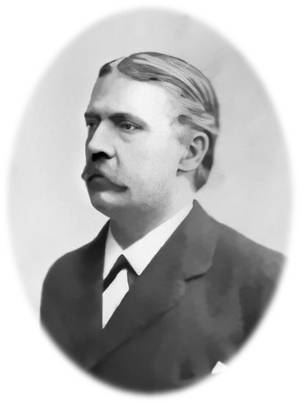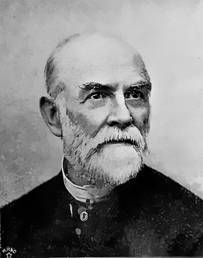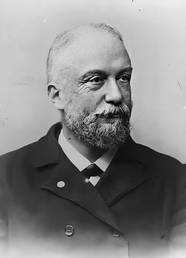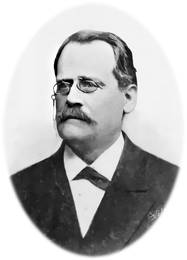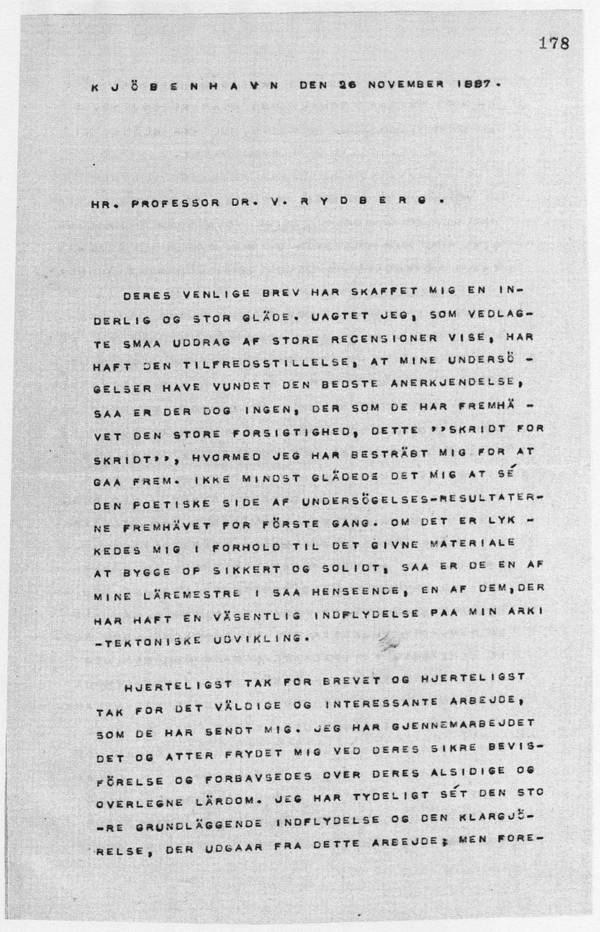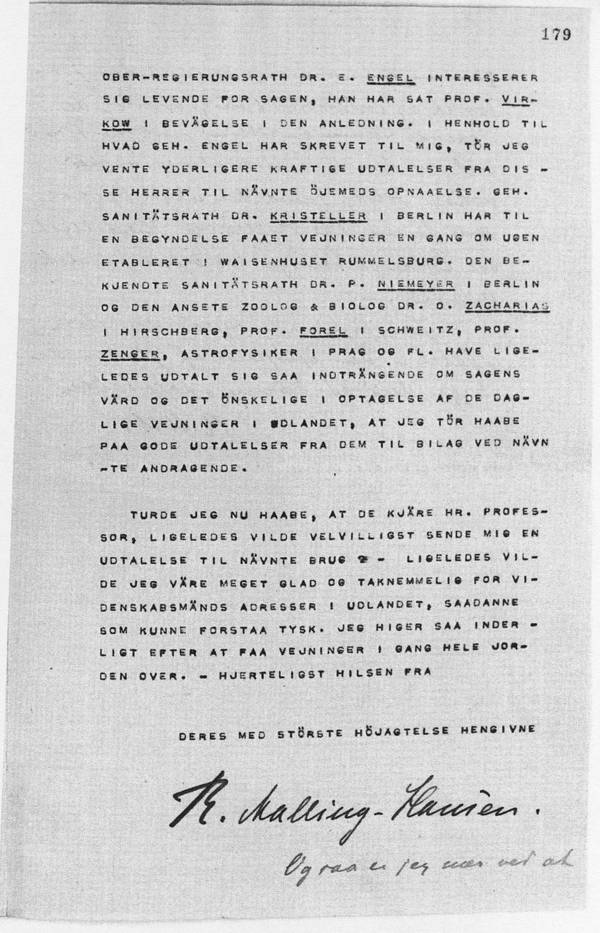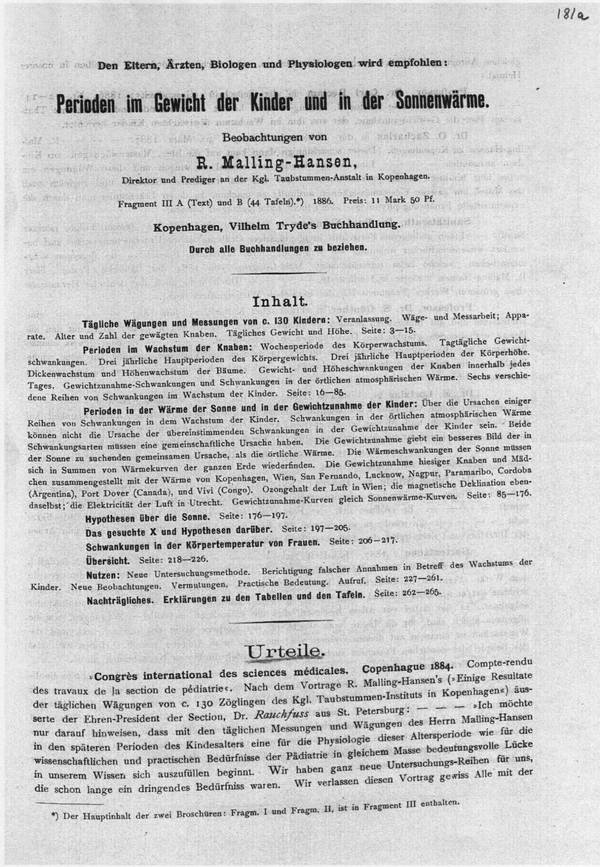1887.11.26 English
C O P E N H A G E N NOVEMBER 26, 1887
DEAR PROFESSOR RYDBERG[1]
YOUR KIND LETTER[2] HAS REJOICED ME PROFOUNDLY. THE ENCLOSED SHORT EXCERPTS OF LENGHTY REVIEWS[3] DO SHOW THAT I HAVE HAD THE SATISFACTION OF HAVING MY INVESTIGATIONS WIN THE HIGHEST PRAISE, BUT STILL: UNTIL NOW NO ONE HAS, LIKE YOU DO IT, THROWN INTO RELIEF THE GREAT CAUTIOUSNESS, THIS “STEP-BY-STEP” METHOD, BY WHICH I HAVE ENDEAVOURED TO ADVANCE. I AM PARTICULARLY PLEASED TO SEE, FOR THE VERY FIRST TIME, THE POETIC ASPECTS OF THE RESEARCH RESULTS BEING BROUGHT OUT. IF I HAVE SUCCEEDED IN BUILDING UP SOMETHING SOLID AND SOUND IN RELATION TO THE RAW MATERIAL AT HAND, I COUNT YOU, SIR, AS ONE OF MY MENTORS IN THIS RESPECT, ONE OF THOSE THAT HAVE HAD A DECISIVE INFLUENCE ON MY ARCHITECTONIC[4] DEVELOPMENT. MY MOST SINCERE GRATITUDE FOR THE LETTER AND FOR THE GRAND AND VERY INTERESTING PIECE OF WORK, THAT YOU SENT ME[5]. I HAVE STUDIED IT CAREFULLY AND ONCE AGAIN I HAVE BEEN DELIGHTED BY YOUR UNERRING ARGUMENTATON, AS WELL AS AMAZED BY YOUR ALL-ROUND AND SUPERIOR ERUDITION. I HAVE VERY CLEARLY SEEN THE GREAT PIONEERING INFLUENCE AND THE ELUCIDATION THAT EMANATES FROM THIS PIECE OF WORK[6]; HOWEVER, AT THIS POINT IN TIME IT IS IMPOSSIBLE FOR ME TO RECIPROCATE WITH SUCH AN AMAZINGLY CLEAR REVIEW OF THE MAJOR ISSUES AS THE ONE THAT YOU, SIR, HAVE DELIGHTED ME WITH IN RELATION TO MY FRAGMENT.
APART FROM THAT, I AM SURPRISED THAT YOU KNEW BEFOREHAND ABOUT MY WEIGHING & MEASURING WORKS. FROM SWEDEN I HAVE ONLY RECEIVED ONE SINGLE REVIEW, AND THAT WAS IN “GÖTEBORGS HANDELS- OCH SJÖFARTSTIDNING”[7].
SIR, MAY I BE ALLOWED TO BOTHER YOU WITH THE FOLLOWING: - BY NOW YOU WILL HAVE OBSERVED THAT IN ORDER TO OBTAIN ACCURATE KNOWLEDGE OF THE CONGRUITIES AND INCONGRUITIES IN RELATION TO THE GROWTH CURVES OF CHILDREN IN DIFFERING POSITIONS OF LATITUDE AND LONGITUDE ON THE PLANET, AS WELL AS FULL COMPREHENSIBILITY AND EVIDENCE OF THE PRESUMED COSMIC LAW FOR THE SIMULTANOUS WORLDWIDE WEIGHT OSCILLATIONS, MANY COLLABORATORS ARE REQUIRED. THEREFORE MY INTENTION IS – HOPEFULLY WITH RECOMMENDATIONS FROM LOCAL MINISTRIES HERE – TO APPLY TO FOREIGN MINISTRIES OF EDUCATION THAT AT LEAST IN ONE BOARDING SCHOOL FOR CHILDREN IN EACH COUNTRY DAILY WEIGHINGS MAY BE CARRIED OUT. ADMITTEDLY, I DO HAVE A GOOD COLLECTION OF PRINTED STATEMENTS CONCERNING THE WEIGHINGS, WHICH I CAN ATTACH TO SUCH A REQUEST; HOWEVER, I WOULD CONSIDER IT AS A PARTICULARLY PROMOTIONAL AND DRIVING FORCE IF I WERE ABLE TO PRESENT STATEMENTS FROM ESTEEMED SCIENTISTS TO THE EFFECT THAT SUCH DAILY WEIGHINGS IN ALL COUNTRIES – FOR THE UPPER MENTIONED BENEFIT – WOULD BE BOTH RELEVANT AND HIGHLY DESIRABLE . – THE PREVIOUS DIRECTOR GENERAL OF THE STATISTICAL[8] DEPARTMENT IN BERLIN, GEH.OBERREGIERUNGSRAT[9] DR. E. ENGEL IS VIVIDLY INTERESTED IN THIS MATTER, AND HE HAS ALSO INVOLVED PROF. VIRKOW . IN REFERENCE TO WHAT DR ENGEL HAS WRITTEN TO ME, I HAVE REASONS TO EXPECT FURTHER AND STRONGLY SUPPORTIVE STATEMENTS FROM THESE GENTLEMEN FOR REACHING THE SAID GOAL. HEALTH COUNSELLOR DR KRISTELLER IN BERLIN HAS MANAGED, AS A START, TO ESTABLISH WEEKLY WEIGHINGS AT THE ORPHANAGE OF RUMMELSBERG. THE WELL-KNOWN HEALTH COUNSELLOR DR. P. NIEMEYER IN BERLIN AND THE RESPECTED ZOOLOGIST & BIOLOGIST DR O. ZACHARIAS IN HIRSCHBERG, PROF. FOREL IN SWITZERLAND, PROF. ZENGER, ASTROPHYSICIST IN PRAGUE AND OTHERS HAVE ALSO PROVIDED SUCH SERIOUS STATEMENTS ABOUT THE VALUE OF THIS ISSUE AND THE DESIRABILITY OF INITIATING DAILY WEIGHINGS ABROAD THAT I VENTURE TO HOPE FOR A POSITIVE REFERENCE FROM YOU, SIR, TO BE USED AS AN ATTACHMENT TO THE SAID APPLICATION.
DARE I HOPE, DEAR PROFESSOR, THAT ALSO YOU MAY KINDLY SEND ME A STATEMENT TO THIS EFFECT? – LIKEWISE, I WOULD BE VERY PLEASED AND GRATEFUL FOR ADDRESSES TO SCIENTISTS ABROAD, WITH WHICH I CAN COMMUNICATE IN GERMAN. I DESIRE ARDENTLY TO GET WEIGHINGS STARTED AROUND THE GLOBE. – VERY BEST WISHES AND REGARDS FROM
YOUR OBEDIENT AND DEVOTED SERVANT
R. Malling-Hansen
And[10] I almost forgot that which has so much amazed and interested me, namely the striking comparison between Fimbul[11] and the northern ice age[12] of the great 21000 year period, in
[1] CB: This is the second letter from RMH to Prof. Rydberg. The other two are dated 18871018UK and 18871128UK. A detailed fact sheet on Viktor Rydberg can be found with the letter 18871018UK.
[2] SA: Viktor Rydberg's reply to TMH's first letter was dated 18871112 and can be found in the list of letters.
[3] CB: RMH is referring to two enclosed pages with a large number of reviews from German papers of the German edition of RMH’s work: “Periods in the Growth of the Weight of Children and Solar Heat”
[4] CB: The choice of wording is odd? He probably means “research methodological development” or something to that effect?
JMC/SA: Probably RMH is using this word in an archaic and poetic meaning; apart from meaning “master builder”, ‘architect’ can also mean ‘creator, deviser or maker of anything’. It is in RMH’s style and personality to use a colourful language.
[5] JMC: We don’t know which of his works Rydberg forwarded, but from the context and from RMH’s comments we may presume that it was one of Rydberg’s books on mythology, religion or cultural history (see the complete list of his publications in the fact sheet attached to letter 18871018UK)
SA: After Rydberg's reply to RMH was discovered, we can be sure that the title of the book really was “Investigations in Germanic Mythology”.
[6] CB: I wonder what work this could be – something of relevance to the ”periods” of RMH?
JMC: Possibly Rydberg’s “Investigations in Germanic Mythology” in two parts, published 1886 and 1889, because Rydberg must have been occupied with this book at the time of the exchange of letters with RMH, and it would therefore be logical for him to share some of his conclusions with the theologically educated Malling-Hansen.
[7]JMC: Translated as ”The Commerce and Maritime Paper of Gothenburg” – one of the leading daily newspapers in the 19th century in Sweden, known and respected for its high quality journalism as well as for its politically radical standpoints in the public debate. Rydberg served as a journalist for a number of years and also as an editorial member.
[8] CB: The letter has ”statical” (in Danish: ”statiske”)- ”statistical” must be the intention.
[9] JMC: A German title of a high-ranking government official
[10] CB: These are 10 lines written by hand
[11] JMC: ’Fimbul’ is part of Norse mythology, the word meaning ‘the great winter’. It was believed that a fimbul winter would come and that it would have three successive winters without any intervening summers. This would be the immediate prelude to the end of the world, Ragnarök. The fact that RMH mentions this aspects as one of the themes of Prof Rydberg’s book, supports the supposition that the piece of work Rydberg had sent to RMH was, in fact, ‘Investigations in Germanic Mythology”
SA: See also Viktor Rydberg's reply, dated 18871112, that was found after the first footnotes were written.
[12] JMC: It is today well-established scientifically based knowledge that the last ice age started 1 million years ago and ended around 10 000 years ago. We are at present in an interglacial period. The concept of ice ages originated in the 19th century and it is quite possible that RMH and Rydberg were both well acquainted with the notion. No single person ‘invented’ the idea; but between 1825 and 1833 Jean de Charpentier assembled evidence in support of the concept. In 1836 Charpentier and a Swiss engineer by the name of Ignatz Venetz convinced Louis Agassiz of the theory, and published it in his book ‘Etude sur les glaciers’ of 1840.
PROFILES OF KEY PERSONS MENTIONED BY RMH IN 18871126UK:
Ernst Engel (1821-1896), German statistician and economist, known for his so called “Engel’s law” concerning the relationship between demand and economic growth. For many years he held the post of Director of the Statistical Department in Berlin and rose to the level of “Geheimer Regierungsrat”. A very productive writer, mainly in publications that he himself founded.
Rudolf Virchow (1821-1902), German medical doctor, anthropologist, public advocate of healthy living, pathologist, historian, biologist and politician. Often referred to as “the father of pathology”. Professor of biological pathology at the University of Berlin. Made many epoch-making discoveries and is credited as being the first one to discover leukaemia. Perhaps most famous for his theory ‘Omnis cellula e cellula’ (“each cell has its origin in an already existing cell which is identical to it”).
Paul Niemeyer (1832-1890), MD, known for his great achievements within public healthcare and alternative therapeutic methods such as diets, fresh air, body hygiene and playful physical exercises. He was very active as a lecturer and writer, and he is regarded as the founder of therapies based on herbal or natural medicines as an alternative to the established modern medical tradition. Judging from Malling-Hansen’s initiatives to improve the living conditions of deaf-mute children we know that he was preoccupied with the same lines of thought as Niemayer – possibly inspired by the writings of Niemayer? At any rate, Malling-Hansen took responsibility for the pupils of the institute for the deaf-mute to enjoy an improved diet, better physical exercise and more access to fresh air, something that drastically improved their condition of health. In his letters to his daughter Emma, who was suffering from homesickness during her year in England, RMH always stressed the importance that she had plenty of fresh air in her room, and at the institute he arranged for air ducts to be installed!
Eduard Zacharias (1852-1911), German botanist, doctor of philosophy, lecturer and professor. Even if RMH’s letter indicates ‘O. Zacharias’, we think that RMH must have been corresponding with Eduard Zacharias, since he is the only well-known biologist of this surname in the period in question. For many years Zacharias was head of the Hamburg Botanical State Institute, initially carrying out extensive research within the field of growth anatomy of plants, and later on focusing on research within the field of cytology, gaining recognition as a great authority in this field. In addition, he was an outstanding expert at horticultural exhibitions in Germany as well as abroad and a specialist in the biology of flowering, e.g. within the field of cultivation of fruit trees. It is quite logical that RMH must have benefited quite a lot from his contact with Zacharias in connection with his studies of arboreal growth.
August Forel (1848-1931), a world famous Swiss psychiatrist, professor, brain researcher, social reformer, peace worker and heavily involved in social debate. A biographer referred to him as “the strongest and purest voice for the conscience of the world”. Forel was a universal genius of the same caliber as RMH, and his interests spanned a wide and diversified field. As a world famous brain researcher he emphasized the unity of brain and soul – a position that brought him under attack from the established church. He became a member of the Bahai religion in 1920. He was a world leading expert on the study of ants. Forel was an internationalist, pacifist, protagonist of the temperance movement and also an advocate for Esperanto. He took the initiative to establish a large number of new institutions and also contributed with a great many discoveries and inventions within several different subject areas. Forel’s scientific production includes 591 books and articles, and he published 564 newspapers articles. In honour of his gigantic life’s work his portrait adorned the Swiss 1000 franc note between 1978 and 1998.
Karel Zenger (1830-1908), Czech mathematician, physicist, astro-physiscist, professor at the Czech Technical University in Prague. It has not been possible to find a biography on Zenger in any other languages than Czech, and therefore it is not easy to provide information about him, but it is evident that he was a very much outstanding personality in his time, and we know that he published a book entitled “Die Meteorologie der Sonne und ihres Systems”. It is probably in his capacity as astro-physicist that Malling-Hansen took an interest in his expertise, since RMH was searching for the unknown factor that determined growth in nature and was of the opinion that this factor could be found in the sun rays and solar heat.
SA/JMC

